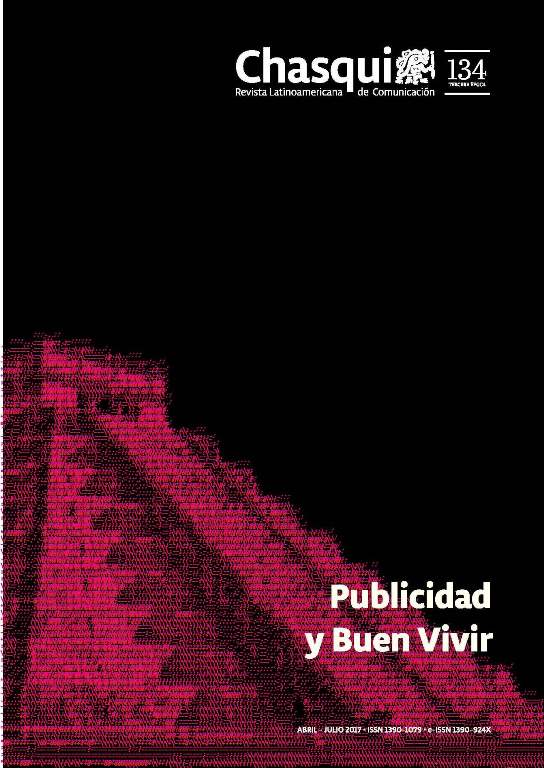Videoactivism and technology embracing. The case of 15m.cc
DOI:
https://doi.org/10.16921/chasqui.v0i134.2959Keywords:
emancipation, social appropriation, 15M, networked actors, transformative subjectivityAbstract
The emergence of a wave of citizen protest since 2011 has foreshadowed the advent of different subjectivities largely defined by innovative cultural dynamics and by the use of the Internet as a source of emancipation. This text engages critically with the relationship between social appropriation patterns on the Internet and the emergence of a new actor-network as defined by these initiatives. The social and cultural context which sustains the analysis points towards video-activism in the “indignados” movement in Spain and, specifically, to the case of 15m.cc as an emancipatory exercise which revolves around three main points: re-collectivization of social action on-line, individual positioning in relation to the so-called “voice of the crowd” and the use of anonymity and transparency.References
Althusser, L. (1971). Ideology and Ideological State Apparatuses. En Lenin and Philosophy and other Essays. Londres: Monthly Review Press.
Andrejevic, M. (2009) Exploiting YouTube: Contradictions of User-Generated Labor. En Snickars & Vonderau (Eds.), The YouTube Reader. Stockholm: National Library of Sweden.
Askanius, T. (2014). Video for Change. En Wilkins, Tufte & Obregon (Eds.), The Handbook of Development Communication and Social Change. Londres: Wiley-Blackwell
Bouhaben, M. A. (2014). La política audiovisual. Crítica y estrategia en la producción y distribución de los documentales del 15M. Fotocinema, 28, 223-253.
Bourdieu, P. (1998). La distinción: criterios y bases sociales del gusto. Barcelona: Taurus Ediciones.
Castells, M. (2009). Comunicación y poder. Madrid: Alianza Editorial.
Cunha, T. C. (2004). Argumentaçao e Critica. Coimbra: Almedina.
Burgess, J. & Green, J. (2009). YouTube. Online Video and Participatory Culture. Londres: Polity.
Dahlgren, P. (2005). The Internet, Public Spheres, and Political Communication: Dispersion and Deliberation. Political Communication, 22: 2, 47-162. DOI: http://bit.ly/2nx50zI.
De Cauter, L. (2004). The capsule and the network: notes towards a general theory. En Graham, S. (Ed.), The Cybercities Reader. Londres: Routledge.
De Certeau, M. (1996). La invención de lo cotidiano. Artes de hacer. México: UIA-Iteso.
Fernández-Savater, A. (2013). La Cultura de la Transición y el nuevo sentido común. Interferencias Disponible en http://bit.ly/2nR8yha. Consultado el 1/02/2015.
Gerbaudo, P. (2012). Tweets and the Streets: Social Media and Contemporary Activism. Londres: Pluto Press.
Hardt, M. & Negri, T. (2004). Multitud. Barcelona: Debate.
Juris, J. (2008), Networking Futures: The Movement Against Corporate Globalization. Nueva York: Duke University Press.
Kim, J. (2012). The institutionalization of YouTube: From user generated content to professionally generated content. Media Culture Society. 34 (I). DOI: http://bit.ly/2nNP4JX.
Laclau, E. (2005). On Populist Reason. Londres: Verso.
Margetts, H. (2011). The Internet and Transparency. The Political Quarterly. 82 (4), 518-521. DOI: http://bit.ly/2n2KdAT.
Mateos, C. & Rajas, M. (2014). Videoactivismo: conceptos y rasgos, en VVAA, Videoactivismo. Acción política, cámara en mano. Cuadernos Artesanos de Comunicación, 71. La Laguna (Tenerife): Latina, (15-56). http://bit.ly/2nNDJJC. Consultado el 13/12/2014.
Montero, D. & Sierra, F. (2015). Videoactivismo y movimientos sociales. Teoría y praxis de las multitudes conectadas. Barcelona: Gedisa.
Montero, D. & Candón, J. (2015). Prácticas audiovisuales emancipadoras en el entorno del movimiento 15M. En Montero & Sierra (eds.), Videoactivismo y movimientos sociales. Teoría y praxis de las multitudes conectadas. Gedisa: Barcelona.
Moreno-Caballud, L. (2013) Cultures of Anyone. The Spanish “Indignado” Movement and its Contexts. Culturas de cualquiera. Blog. http://bit.ly/2n2Lfgh. Consultado el 02/03/2015.
Morozov, E. (2011). The Net Delusion: The Dark Side of Internet Freedom. Nueva York: Public Affairs.
Norris, P. (2001). Digital Divide. Civic Engagement, Information Poverty, and the Internet Worldwide. Cambridge: Cambridge University Press.
Rancière, J. (2010). El espectador emancipado. Madrid: Ellago Ediciones.
Rendueles C. (2013), Sociofobia. El cambio político en la era de la utopía digital. Madrid: Capitan Swing Libros.
Van Bavel, R.; Punie, Y. & Tuami, I. (2004). Cambios en el capital social, posibilidades por las TIC. Technical Report Series, EUR 21064, Institute for Prospective Technological Studies (IPTS) of European Commission, 85. Seville: IPTS.
Van Dijk, J. (2008). Users like you? Theorizing agency in user-generated content. Media Culture Society. 31 (1). DOI: http://bit.ly/2o0xY8T.
Wasko, J. & Erickson, M. (2009). The Political Economy of YouTube. En Snickars & Vonderau (Eds.) The YouTube Reader. Stockholm: National Library of Sweden.
Wellman, B. (2002). Little boxes, glocalization, and networked individualism. En Tanabe, Besselaar & Ishida (Eds.), Digital cities II: Computational and sociological approaches. Berlín: Springer.
Zhao, S.; Grasmuck, S. & Martin, J. (2008). Identity construction on Facebook: Digital empowerment in anchored relationships. Computers in human behavior, 24(5). DOI: http://bit.ly/2n0n80X.
Downloads
Published
Issue
Section
License
- Authors retain copyright and grant the journal right of first publication with the work simultaneously licensed under a Creative Commons Attribution-NoDerivs License (CC BY-ND) that allows others to share the work with an acknowledgement of the work's authorship and initial publication in this journal.
- Authors are able to enter into separate, additional contractual arrangements for the non-exclusive distribution of the journal's published version of the work (e.g., post it to an institutional repository or publish it in a book), with an acknowledgement of its initial publication in this journal.
- Authors are permitted and encouraged to post their work online.

